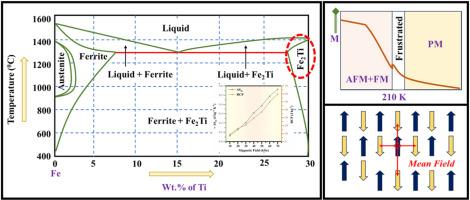Magnetic behaviour and magnetic entropy change of laves phase Fe2Ti intermetallic
IF 2.4
4区 物理与天体物理
Q3 PHYSICS, CONDENSED MATTER
引用次数: 0
Abstract
The deep insights into the magnetic and magnetocaloric behaviour of polycrystalline C14 laves phase Fe2Ti is performed. The synthesized phase pure alloy exhibits both antiferromagnetic and ferromagnetic interactions, evident from magnetization measurements. The possibility for the occurrence of antisite disorder can be ascribed to the reason for the occurrence of mixed magnetic interactions. The critical behaviour of the alloy within the transition regime is also studied. This revealed the presence of 3D mean field type spin alignment with long-range ordering in Fe2Ti. The maximum entropy change and relative cooling power of −0.56 J kg−1 K−1 and 59.88 J kg−1 is attained at 273 K for an external magnetic field change of 70 kOe. This study reveals the possible exploration of Laves phase Fe2Ti based intermetallic for room temperature solid state refrigeration.

laves相Fe2Ti金属间化合物的磁性行为和磁熵变化
对多晶C14叶片相Fe2Ti的磁性和磁热行为进行了深入的研究。合成的相纯合金表现出反铁磁和铁磁相互作用,从磁化测量中可以看出。反位无序发生的可能性可归因于混合磁相互作用发生的原因。研究了合金在过渡区内的临界行为。这揭示了Fe2Ti中存在具有长程有序的三维平均场型自旋排列。当外加磁场变化为70koe时,273 K下的最大熵变和相对冷却功率分别为- 0.56 J kg - 1 K - 1和59.88 J kg - 1。本研究揭示了Laves相Fe2Ti基金属间化合物用于室温固态制冷的可能探索。
本文章由计算机程序翻译,如有差异,请以英文原文为准。
求助全文
约1分钟内获得全文
求助全文
来源期刊

Solid State Communications
物理-物理:凝聚态物理
CiteScore
3.40
自引率
4.80%
发文量
287
审稿时长
51 days
期刊介绍:
Solid State Communications is an international medium for the publication of short communications and original research articles on significant developments in condensed matter science, giving scientists immediate access to important, recently completed work. The journal publishes original experimental and theoretical research on the physical and chemical properties of solids and other condensed systems and also on their preparation. The submission of manuscripts reporting research on the basic physics of materials science and devices, as well as of state-of-the-art microstructures and nanostructures, is encouraged.
A coherent quantitative treatment emphasizing new physics is expected rather than a simple accumulation of experimental data. Consistent with these aims, the short communications should be kept concise and short, usually not longer than six printed pages. The number of figures and tables should also be kept to a minimum. Solid State Communications now also welcomes original research articles without length restrictions.
The Fast-Track section of Solid State Communications is the venue for very rapid publication of short communications on significant developments in condensed matter science. The goal is to offer the broad condensed matter community quick and immediate access to publish recently completed papers in research areas that are rapidly evolving and in which there are developments with great potential impact.
 求助内容:
求助内容: 应助结果提醒方式:
应助结果提醒方式:


